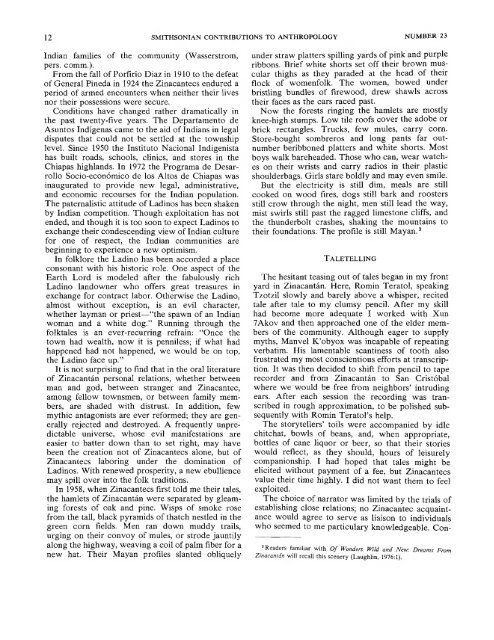PDF (Lo-Res) - Smithsonian Institution Libraries
PDF (Lo-Res) - Smithsonian Institution Libraries
PDF (Lo-Res) - Smithsonian Institution Libraries
You also want an ePaper? Increase the reach of your titles
YUMPU automatically turns print PDFs into web optimized ePapers that Google loves.
12 SMITHSONIAN CONTRIBUTIONS TO ANTHROPOLOGY NUMBER 23<br />
Indian families of the community (Wasserstrom,<br />
pers. comm.).<br />
From the fall of Porfirio Diaz in 1910 to the defeat<br />
of General Pineda in 1924 the Zinacantecs endured a<br />
period of armed encounters when neither their lives<br />
nor their possessions were secure.<br />
Conditions have changed rather dramatically in<br />
the past twenty-five years. The Departamento de<br />
Asuntos Indigenas came to the aid of Indians in legal<br />
disputes that could not be settled at the township<br />
level. Since 1950 the Instituto Nacional Indigenista<br />
has built roads, schools, clinics, and stores in the<br />
Chiapas highlands. In 1972 the Programa de Desarrollo<br />
Socio-economico de los Altos de Chiapas was<br />
inaugurated to provide new legal, administrative,<br />
and economic recourses for the Indian population.<br />
The paternalistic attitude of Ladinos has been shaken<br />
by Indian competition. Though exploitation has not<br />
ended, and though it is too soon to expect Ladinos to<br />
exchange their condescending view of Indian culture<br />
for one of respect, the Indian communities are<br />
beginning to experience a new optimism.<br />
In folklore the Ladino has been accorded a place<br />
consonant with his historic role. One aspect of the<br />
Earth <strong>Lo</strong>rd is modeled after the fabulously rich<br />
Ladino landowner who offers great treasures in<br />
exchange for contract labor. Otherwise the Ladino,<br />
almost without exception, is an evil character,<br />
whether layman or priest—"the spawn of an Indian<br />
woman and a white dog." Running through the<br />
folktales is an ever-recurring refrain: "Once the<br />
town had wealth, now it is penniless; if what had<br />
happened had not happened, we would be on top,<br />
the Ladino face up."<br />
It is not surprising to find that in the oral literature<br />
of Zinacantan personal relations, whether between<br />
man and god, between stranger and Zinacantec,<br />
among fellow townsmen, or between family members,<br />
are shaded with distrust. In addition, few<br />
mythic antagonists are ever reformed; they are generally<br />
rejected and destroyed. A frequently unpredictable<br />
universe, whose evil manifestations are<br />
easier to batter down than to set right, may have<br />
been the creation not of Zinacantecs alone, but of<br />
Zinacantecs laboring under the domination of<br />
Ladinos. With renewed prosperity, a new ebullience<br />
may spill over into the folk traditions.<br />
In 1958, when Zinacantecs first told me their tales,<br />
the hamlets of Zinacantan were separated by gleaming<br />
forests of oak and pine. Wisps of smoke rose<br />
from the tall, black pyramids of thatch nestled in the<br />
green corn fields. Men ran down muddy trails,<br />
urging on their convoy of mules, or strode jauntily<br />
along the highway, weaving a coil of palm fiber for a<br />
new hat. Their Mayan profiles slanted obliquely<br />
under straw platters spilling yards of pink and purple<br />
ribbons. Brief white shorts set off their brown muscular<br />
thighs as they paraded at the head of their<br />
flock of womenfolk. The women, bowed under<br />
bristling bundles of firewood, drew shawls across<br />
their faces as the cars raced past.<br />
Now the forests ringing the hamlets are mostly<br />
knee-high stumps. <strong>Lo</strong>w tile roofs cover the adobe or<br />
brick rectangles. Trucks, few mules, carry corn.<br />
Store-bought sombreros and long pants far outnumber<br />
beribboned platters and white shorts. Most<br />
boys walk bareheaded. Those who can, wear watches<br />
on their wrists and carry radios in their plastic<br />
shoulderbags. Girls stare boldly and may even smile.<br />
But the electricity is still dim, meals are still<br />
cooked on wood fires, dogs still bark and roosters<br />
still crow through the night, men still lead the way,<br />
mist swirls still past the ragged limestone cliffs, and<br />
the thunderbolt crashes, shaking the mountains to<br />
their foundations. The profile is still Mayan. 3<br />
TALETELLING<br />
The hesitant teasing out of tales began in my front<br />
yard in Zinacantan. Here, Romin Teratol, speaking<br />
Tzotzil slowly and barely above a whisper, recited<br />
tale after tale to my clumsy pencil. After my skill<br />
had become more adequate I worked with Xun<br />
7Akov and then approached one of the elder members<br />
of the community. Although eager to supply<br />
myths, Manvel K'obyox was incapable of repeating<br />
verbatim. His lamentable scantiness of tooth also<br />
frustrated my most conscientious efforts at transcription.<br />
It was then decided to shift from pencil to tape<br />
recorder and from Zinacantan to San Cristobal<br />
where we would be free from neighbors' intruding<br />
ears. After each session the recording was transcribed<br />
in rough approximation, to be polished subsequently<br />
with Romin Teratol's help.<br />
The storytellers' toils were accompanied by idle<br />
chitchat, bowls of beans, and, when appropriate,<br />
bottles of cane liquor or beer, so that their stories<br />
would reflect, as they should, hours of leisurely<br />
companionship. I had hoped that tales might be<br />
elicited without payment of a fee, but Zinacantecs<br />
value their time highly. I did not want them to feel<br />
exploited.<br />
The choice of narrator was limited by the trials of<br />
establishing close relations; no Zinacantec acquaintance<br />
would agree to serve as liaison to individuals<br />
who seemed to me particulary knowledgeable. Con-<br />
familiar with Of Wonders Wild and New: Dreams From<br />
Zinacantan will recall this scenery (Laughlin, 1976:1).

















